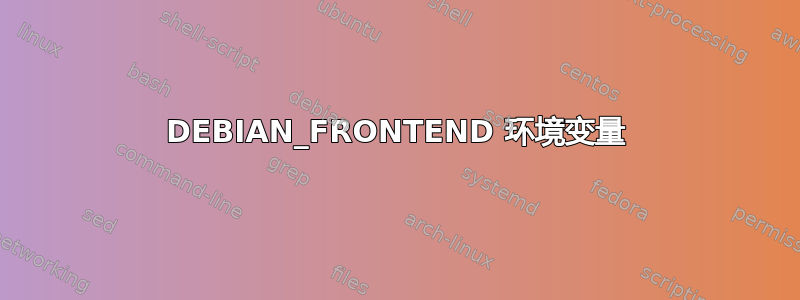
我的潜在托管服务提供商建议在终端中运行命令,以使基于 KVM 的服务器的操作系统映像最小化。由于他们的 KVM 模板附带了我不需要的软件包,所以我想我可以使用相同的命令来删除不需要的软件包。
该命令以 开头DEBIAN_FRONTEND=noninteractive,然后调用apt-get remove如下:
DEBIAN_FRONTEND=noninteractive apt-get remove --purge -y -o Dpkg::Options::="--force-confdef" -o Dpkg::Options::="--force-confold" package-1 package-2 ... package-n; apt-get -y autoremove; apt-get clean all
这是我第一次遇到DEBIAN_FRONTEND环境变量,到目前为止我找不到有用的信息。所以我想知道将它设置为什么noninteractive,以及是否可取,因为我认为该值(noninteractive)会持续存在。
答案1
简单地在apt命令前面添加DEBIAN_FRONTEND=something,在应用该命令的单个命令之后不会持续存在。
这些DEBIAN_FRONTEND选项记录在第 7 节手册页中debconf(您可能需要安装该debconf-doc软件包才能在您的系统上使用它们)。来自man 7 debconf:
Frontends
One of debconf's unique features is that the interface it presents to
you is only one of many, that can be swapped in at will. There are many
debconf frontends available:
dialog The default frontend, this uses the whiptail(1) or dialog(1)
programs to display questions to you. It works in text mode.
readline
The most traditional frontend, this looks quite similar to how
Debian configuration always has been: a series of questions,
printed out at the console using plain text, and prompts done
using the readline library. It even supports tab completion. The
libterm-readline-gnu-perl package is strongly recommended if you
chose to use this frontend; the default readline module does not
support prompting with default values. At the minimum, you'll
need the perl-modules package installed to use this frontend.
This frontend has some special hotkeys. Pageup (or ctrl-u) will
go back to the previous question (if that is supported by the
package that is using debconf), and pagedown (or ctrl-v) will
skip forward to the next question.
This is the best frontend for remote admin work over a slow con‐
nection, or for those who are comfortable with unix.
noninteractive
This is the anti-frontend. It never interacts with you at all,
and makes the default answers be used for all questions. It
might mail error messages to root, but that's it; otherwise it
is completely silent and unobtrusive, a perfect frontend for
automatic installs. If you are using this front-end, and require
non-default answers to questions, you will need to preseed the
debconf database; see the section below on Unattended Package
Installation for more details.
它还指出:
You can change the default frontend debconf uses by reconfiguring deb‐
conf. On the other hand, if you just want to change the frontend for a
minute, you can set the DEBIAN_FRONTEND environment variable to the
name of the frontend to use. For example:
DEBIAN_FRONTEND=readline apt-get install slrn
The dpkg-reconfigure(8) and dpkg-preconfigure(8) commands also let you
pass --frontend= to them, followed by the frontend you want them to
use.
Note that not all frontends will work in all circumstances. If a fron‐
tend fails to start up for some reason, debconf will print out a mes‐
sage explaining why, and fall back to the next-most similar frontend.



